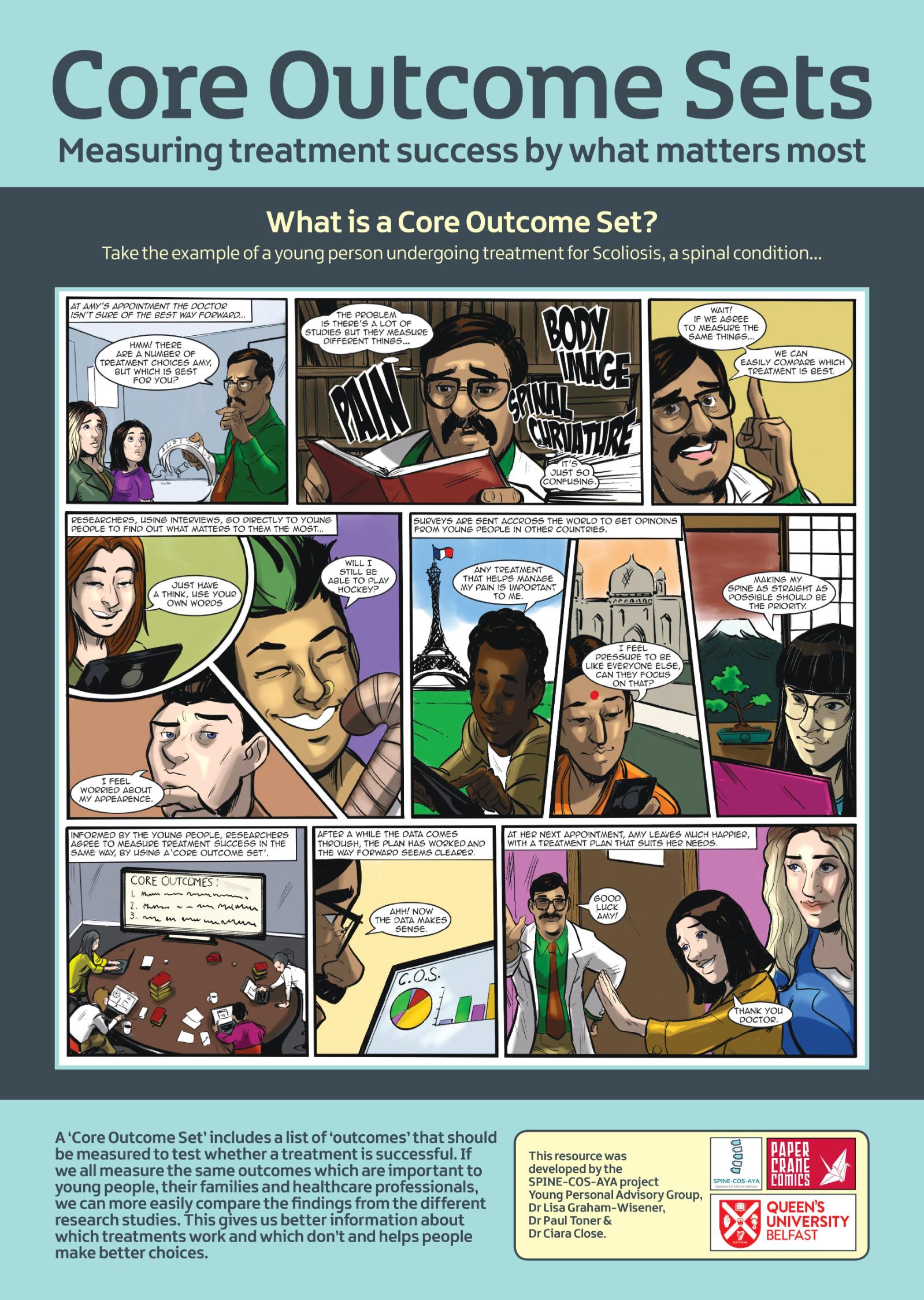SPINE-COS-AYA

Welcome to the information page for the Scoliosis research study
What is this project about?
This short video will provide an overview of the SPINE-COS-AYA research project and its main objectives.
About the research team (in conjunction with the NI Regional Scoliosis Service)
Why is this research study important?
Research is continually ongoing to develop better treatments for Scoliosis, whether this is less invasive surgery or more effective bracing. In order to help patients and healthcare professionals make decisions about treatment, it is important to have the best available research evidence on which treatments work best for young people with scoliosis.
The effect that a treatment has on a patient is measured using an ‘outcome’. An example of an outcome is spinal curvature, and another example of an outcome is psychological wellbeing. There are many different outcomes which can be used to test whether a treatment has been effective.
Often the effect of treatments for health conditions (e.g. scoliosis) are measured using different outcomes, which makes it difficult for researchers to compare their research findings to know which treatment is best. This limits the quality of the research evidence and so patients and healthcare professionals may be unsure which treatment is most effective.
If researchers were to agree to measure the same outcomes for Scoliosis for young people, the findings could be combined or compared which leads to the availability of better quality research evidence. Therefore, it is important to speak to young people with scoliosis, their families and healthcare professionals to ensure that the outcomes which are most important to them are measured.
This agreement on what outcomes at minimum are most important to measure the success of a treatment is called a core outcome set (COS).
What is a Core Outcome Set?
Our young person advisory group and illustrator Jim Lavery from Paper Crane Comics (jimlavery.wordpress.com) co-developed the following comic book resource to aid understanding of core outcome sets (COS). This was made possible by funding from the QUB ESRC Impact Acceleration Account. This resource will be particularly useful for anyone developing COS for young people. Please free to download, use and share widely!

Additionally, you can check out a summary of what a core outcome is in this handy guide from the COMET Initiative (click here to download) and/or by watching the video below:
What is this research aiming to do?
The research team at QUB are working with clinicians in the Northern Ireland Regional Scoliosis Service (BHSCT) to develop a core outcome set for treatment (surgery or bracing) of scoliosis in adolescents and young adults. We hope that this core outcome set when developed will be able to be used by researchers and clinicians across the world, to evaluate whether scoliosis treatments are effective. This will help to advance important research in this area, and improve the quality of life of future young people diagnosed with scoliosis.
To develop the core outcome set we will undertake qualitative research (i.e. interviews) with important groups of individuals to find out what they feel should be measured to test whether a treatment is successful (and why). While COVID-19 restrictions are in place, these interviews will be online or by phone.
We will conduct interviews from May 2021 over approximately 1 year with:
- adolescents and young adults with adolescent idiopathic scoliosis (30-45 young people)
- their parents/ care givers (20-30 parents)
- healthcare professionals (10-15 healthcare professionals)
Who is eligible to take part in this study?
To participate in our adolescents and young adults interviews you must:
- have a diagnosis of Adolescent Idiopathic Scoliosis (scoliosis with no known cause)
- have received your diagnosis when you were at least 10 years old
- be aged 10-25 years old
- have received treatment for Adolescent Idiopathic Scoliosis in the past 5 years (for example bracing or surgery, at least 3 months ago)
To participate in our parent interviews you must:
- be a parent/ guardian/carer giver for a young person aged 10-25 years who has had treatment for Scoliosis in the past 5 years
To participate in our healthcare professional interviews
- You must be a registered healthcare professional working in NI with young people aged 10-25years with a diagnosis of Adolescent Idiopathic Scoliosis
How can I take part in this study?
Taking part is easy, you can contact our research assistant Julie or you can ask your any member of your clinical team at the NI Scoliosis service about taking part.
Julie McMullan julie.mcmullan@qub.ac.uk
Telephone: 07919511950
Facebook: @qubscoliosis
Twitter: @qubscoliosis
Involving young people in this research
We know how important it is to include the voices of young people with Adolescent Idiopathic Scoliosis in our research and this is why we have created two Young Persons Advisory groups (YPAG) one for those aged 10-15years and another for those aged 16-25years. The YPAGS to date have participated in workshops sharing their thoughts on how best to engage with young people with AIS and developing suitable study information sheets. We are always looking to include new members to our YPAG, so if you are a young person with Adolescent Idiopathic Scoliosis and would like to be part of one of the groups, please get in touch with Julie the research assistant for the study.
Here are some of the YPAG members in action:

Further information
The full study protocol is available to read at:
The study is also registered on the COMET website, please click the link below for further information:
https://www.cometinitiative.org/Studies/Details/1555
Funder –British Scoliosis Research Foundation



